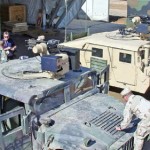
By Pfc. Jerome Bishop, Army News Service

The new CROWS is currently being fielded to Humvees at Life Sustainment Area Anaconda to allow gunners to stay inside their up-armored vehicles while operating their weapons remotely. (Photo by Pfc. Jerome Bishop)
The first group of 35 remotely-operated weapons for mounting on top of Humvees arrived in Iraq recently and the systems were divided among military police, Special Forces, infantry and transportation units.
The Common Remotely Operated Weapon Station, or CROWS as they are known, provide crews the ability to locate, identify and engage targets with better accuracy and improved range, while keeping the gunner inside, protected by the vehicle’s up-armor.
The technology used on the CROWS is a variation of the remote-controlled crew-served weapons system already used on combat vehicles like the Bradley fighting vehicle and the M-1A1 Abrams tank.
“We will be fielding, in the next two years, over 300 systems,” said Picatinny’s Maj. Frank Lozano, the assistant product manager for the CROWS project on Life Sustainment Area Anaconda.
At LSA Anaconda, four CROWS were issued to 2nd Brigade, 2nd Infantry Division, from Ar Ramadi and the 155th Brigade Combat Team on Forward Operating Base Kalsu. Prototypes were installed on vehicles belonging to the 42nd Military Police Brigade in December, Lozano said.
Since then, more CROWS have been installed, bringing the total up to nine systems serving troops at LSA Anaconda.
Presently in Iraq, CROWS are only assembled and fielded at LSA Anaconda. Crews are issued the system there and receive training on how to operate it, said Sgt. 1st Class Jeffrey Januchowski, the project’s training developer.
The nearly $200,000 system is designed to replace the turret gunner on Humvees to improve combat effectiveness, Lozano said.
CROWS allows Soldiers to operate successfully from within the safety of the Humvee’s armor, without being exposed to the threat of improvised explosive devices and small-arms fire.
“The important thing is increased survivability and increased lethality,” Lozano said.
The system incorporates a 15-inch color monitor with live video from cameras in the daytime and thermal imaging cameras in darkness.
Both cameras use a laser range finder, which allows the gunner to zoom on targets, lock onto them and maintain that lock accurately while the vehicle is in motion. The camera and the weapon can be used together or separately.
The camera allows the gunner to look one way with the weapon pointed another. This feature becomes particularly useful when observing suspicious subjects from a distance, Lozano said, adding that way people are not scared off by a weapon pointed at them.
The gun itself is controlled by a joystick which gives the gunner 100-percent functionality, allowing the operator to control the weapon with just one hand. The weapon can be aimed up to 60 degrees above and 20 degrees below in front of the vehicle and can turn a full 360 degrees, allowing the gunner to see almost any threat, no matter where it is located in relation to the vehicle.
With all the features used properly, the weapon can be used at 98-percent accuracy while the vehicle is in motion and the enemy on the run.
“The weapon is smart enough to know your movement, the earth’s movement and the enemy’s movements,” said Lozano.
CROWS is compatible with the M-2 .50-caliber machine gun, M-240B medium machine gun, MK-19 automatic grenade launcher and the M-249 squad automatic weapon.
The weapons operate off of a larger ammunition supply than that of the standard crew-served weapons, Lozano said. He said with larger combat loads, the weapon is reloaded less, keeping the crew inside the vehicle.
The system keeps gunners like Sgt. Darrin Hill, 98th Cavalry, 155th Brigade Combat Team, out of the turret where he had spent his days since being deployed in support of Operation Iraqi Freedom.
“I think it’s a great system. For one, it gets me out of the turret; it gets (me) out of the kill zone,” Hill said. “I feel privileged to be able to learn how to use it.”
(Editor’s note: Pfc. Jerome Bishop is a member of the 1st COSCOM Public Affairs Office at LSA Anaconda.)
In celebration of the 25th anniversary of the Army Acquisition Corps (AAC), Access is publishing articles that highlight milestones throughout the history of the AAC. Each article marks a moment in acquisition excellence.
This article was published in the Picatinny Voice, Friday, April 22, 2005.







